 W
WThe Order of the Black Eagle was the highest order of chivalry in the Kingdom of Prussia. The order was founded on 17 January 1701 by Elector Friedrich III of Brandenburg. In his Dutch exile after World War I, deposed Emperor Wilhelm II continued to award the order to his family. He made his second wife, Princess Hermine Reuss of Greiz, a Lady in the Order of the Black Eagle.
 W
WThe Cross of Merit for Women and Girls was created on 22 March 1871 by Kaiser Wilhelm I, German Emperor, in his capacity as King of Prussia. The award was presented only to women, but was not a Ladies Order in the most narrow sense. Women and girls were awarded at the request of Empress Augusta, and the award was bestowed by the Kaiser.
 W
WThe Royal Order of the Crown was a Prussian order of chivalry. Instituted in 1861 as an honour equal in rank to the Order of the Red Eagle, membership could only be conferred upon commissioned officers, but there was a medal associated with the order which could be earned by non-commissioned officers and enlisted men.
 W
WThe Order of the Württemberg Crown was an order of chivalry in Württemberg.
 W
WThe Order of the Old Nobility, also called Order of the Four Emperors or Ancient Order of Saint George, is a historic chivalric order, first established in 1308. It was re-founded as a secular community on 6 December 1768 by Count Philipp Ferdinand of Limburg Stirum.
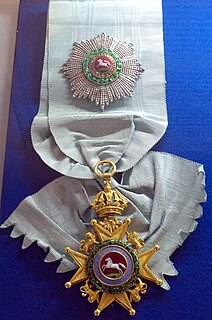 W
WThe Royal Guelphic Order, sometimes referred to as the Hanoverian Guelphic Order, is a Hanoverian order of chivalry instituted on 28 April 1815 by the Prince Regent. It takes its name from the House of Guelph, of which the Hanoverians were a branch. Since Hanover and the United Kingdom shared a monarch until 1837, the order was frequently bestowed upon British subjects.
 W
WThe House Order of Hohenzollern was a dynastic order of knighthood of the House of Hohenzollern awarded to military commissioned officers and civilians of comparable status. Associated with the various versions of the order were crosses and medals which could be awarded to lower-ranking soldiers and civilians.
 W
WThe House-order of the Golden Lion of the German Landgraviate of Hesse-Kassel was instituted on August 14, 1770 by Landgraf (count) Frederick II of Hesse-Kassel. The Order was dedicated to Saint Elizabeth of Hungary, an ancestor of the founder and was meant to reward auspicious merit.
 W
WThe Knights of the Golden Spur were a public official elite of the Holy Roman Empire which consisted mainly of members of the gentry, but also from members of the bourgeoisie and the aristocracy. The term should not be confused with the English knight bachelor, who is frequently termed Eques Auratus in Latin monumental inscriptions, especially from the 17th century, denoting the privilege held by him of being allowed to gild his armour.
 W
WThe Ladies Merit Cross (Frauenverdienstkreuz) was founded on 22 October 1907 by King William II of Prussia as a two-class Ladies Order and to reward women and young women, who worked in the field of charity, or in a religious or social field, who rendered outstanding had personal self-sacrificing service. The award was ranked just behind the Order of Louise. To be awarded the first class, a member must have held the second class for ten years. In exceptional cases, this requirement could be waived. The insignia were returnable upon death.
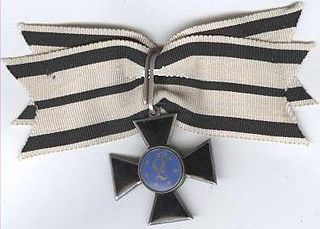 W
WThe Order of Louise was founded on 3 August 1814 by Frederick William III of Prussia to honor his late wife, the much beloved Queen Louise. This order was chivalric in nature, but was intended strictly for women whose service to Prussia was worthy of such high national recognition. Its dame companion members were limited to 100 in number, and were intended to be drawn from all classes.
 W
WThe Ludwig Order (German:"Ludwigsorden"), was an order of the Grand Duchy of Hesse which was awarded to meritorious soldiers and civilians from 1807 to 1918.
 W
WThe Military Order of Max Joseph was the highest military order of the Kingdom of Bavaria. It was founded on 1 January 1806 by Maximilian I Joseph of Bavaria, the first king of Bavaria. The order came in three classes:Grand Cross (Großkreuz) Commander's Cross (Kommandeurkreuz) Knight's Cross (Ritterkreuz).
 W
WThe Order of Olga (Württemberg) (German: Olga-Orden) was created by Karl I, King of Württemberg, on June 27, 1871, to honor his queen consort, Grand Duchess Olga Nikolaevna of Russia. Its primary purpose was to honor women who cared for wounded soldiers in the Franco-Prussian War of 1870 – 1871. While it was conferred on a few men, it remained largely a women's order.
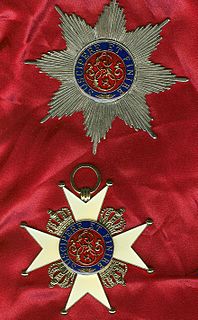 W
WThe Order of Ernst August was founded 15 December 1865 by King George V of Hanover in memory of his father Ernest Augustus, King of Hanover. The order was awarded for both civil and military merit. It was divided in five classes:Grand Cross Grand Commander Commander Officer Knight
 W
WThe Order of Merit of the Bavarian Crown was an order of merit of the Kingdom of Bavaria established by King Maximilian Joseph I on 19 March 1808. The motto of the order is Virtus et Honos. The order was awarded in several grades: Grand Commander, Grand Cross, Commander, Knight, and medals in gold and silver.
 W
WThe Order of Merit of the Prussian Crown was an award of civil and military merit established 18 January 1901 by King Wilhelm II on the occasion of the bicentennial of the establishment of the Kingdom of Prussia. The order was presented in one class and consisted of a badge and a breast star. For military merit the award was presented with crossed swords. The order was presented once with diamonds.
 W
WThe Order of St. George, was founded by Ernest Augustus, King of Hanover, on 23 April 1839. In the statutes establishing the order it was designated as the House Order of the Crown of Hanover. The order is of a single grade and limited to 16 members, excluding members of the royal family.
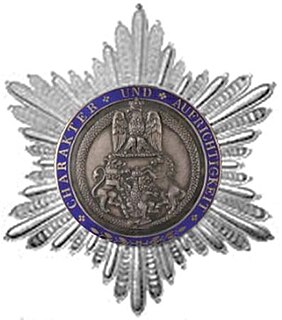 W
WThe Order of the Crown of Westphalia was instituted in Paris on 25 December 1809 by King Hieronymus I of Westphalen, better known as Napoleon's brother Jérôme Bonaparte. The motto of the Order was "CHARACTER UND AUFRICHTIGKEIT". At the back stood the words "ERRICHTET DEN XXV DEZEMBER MDCCCIX".
 W
WThe Order of St Philip of the Lion of Limburg, is an old order of knighthood established in 1700 by the Counts of Limburg-Stirum, sovereign rulers of the counties of the same name in Westfalia. With this order were rewarded persons of exceptional scientific, artistic or civil virtue.
 W
WThe Order of the Red Eagle was an order of chivalry of the Kingdom of Prussia. It was awarded to both military personnel and civilians, to recognize valor in combat, excellence in military leadership, long and faithful service to the kingdom, or other achievements. As with most German orders, the Order of the Red Eagle could only be awarded to commissioned officers or civilians of approximately equivalent status. However, there was a medal of the order, which could be awarded to non-commissioned officers and enlisted men, lower ranking civil servants and other civilians.
 W
WThe Royal Military Order of Saint George for the Defense of the Faith and the Immaculate Conception, also known as the Royal Bavarian House Equestrian Order of Saint George, was founded by Maximilian II Emanuel, Elector of Bavaria in 1726 to provide for a means of honouring the nobility and recognizing distinguished civil and military service. Its status as a Catholic Order was confirmed in a Papal Bull of 15 March 1728 specifically comparing the Order with the Teutonic Order, which had likewise been transformed from a Crusading Order to an exclusive chivalric religious institution for the Nobility.
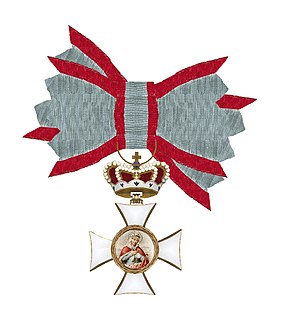 W
WThe Order of Saint Elizabeth was an all-female chivalric and charitable order in the Kingdom of Bavaria. The following excerpt is from The Orders of Knighthood, British and Foreign (1884): The first Consort of the Elector Charles Theodore of the Palatinate, Elizabeth Augusta, daughter of the Palatine Joseph Charles Emanuel of Schultzbach, founded this Order for ladies in honor of her sainted patroness and namesake on the 18th October 1766, as a purely charitable institution for the poor. It was confirmed on the 31st of January 1767, by Pope Clement XII, and endowed with various indulgencies. The Catholic religion and the Seize Quartiers – the proof of noble descent running through sixteen generations of their own or their husband’s ancestors – are indispensable conditions for candidates. The Grand Mistress is, however, empowered to nominate and unlimited number of ladies, from Princely Houses and her own Court, as also six other married or widowed ladies of noble, but not ancient descent. The nomination takes place either on Easter or on Saint Elizabeth’s Day. The entrance fee is four ducats. The badge is a white enameled cross, representing on one side Saint Elizabeth dispensing charity to the poor, and on the other, the initials of the founder. It is worn on the left breast by a blue ribbon with a red border. No Member can appear in public without it, except by fine of one ducat. The King appoints the Grand Mistress.
 W
WThe Order of Sidonia was the German Kingdom of Saxony’s chivalric order for women. Created March 14, 1871 by King John, the order was granted to female members of the Saxon nobility until the fall of the monarchy in 1918. It was named for the duchess of Saxony, Sidonia of Bohemia.
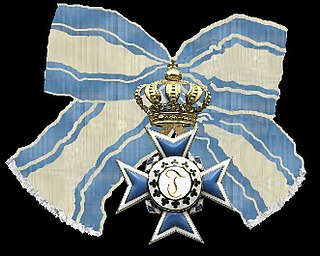 W
WThe Order of Theresa was an order for noble ladies in the Kingdom of Bavaria. It continues to function today as an honorary society to which belong the princesses of the House of Wittelsbach as well as other ladies from Bavarian noble families.
 W
WThe Wilhelm-Orden was instituted on 18 January 1896 by the German Emperor and King of Prussia Willhelm II as a high civilian award, and was dedicated to the memory of his grandfather Emperor William I "the Great".
 W
WThe "Wilhelmsorden" of Hesse-Kassel was instituted by the Elector Friedrich Wilhelm I on 20 August 1851 as a civil and military Order of Merit. It was composed of the three lower grades of the Order of the Golden Lion and a Grand Cross was added. In total the order was awarded more than 450 times in the 16 years of its existence.